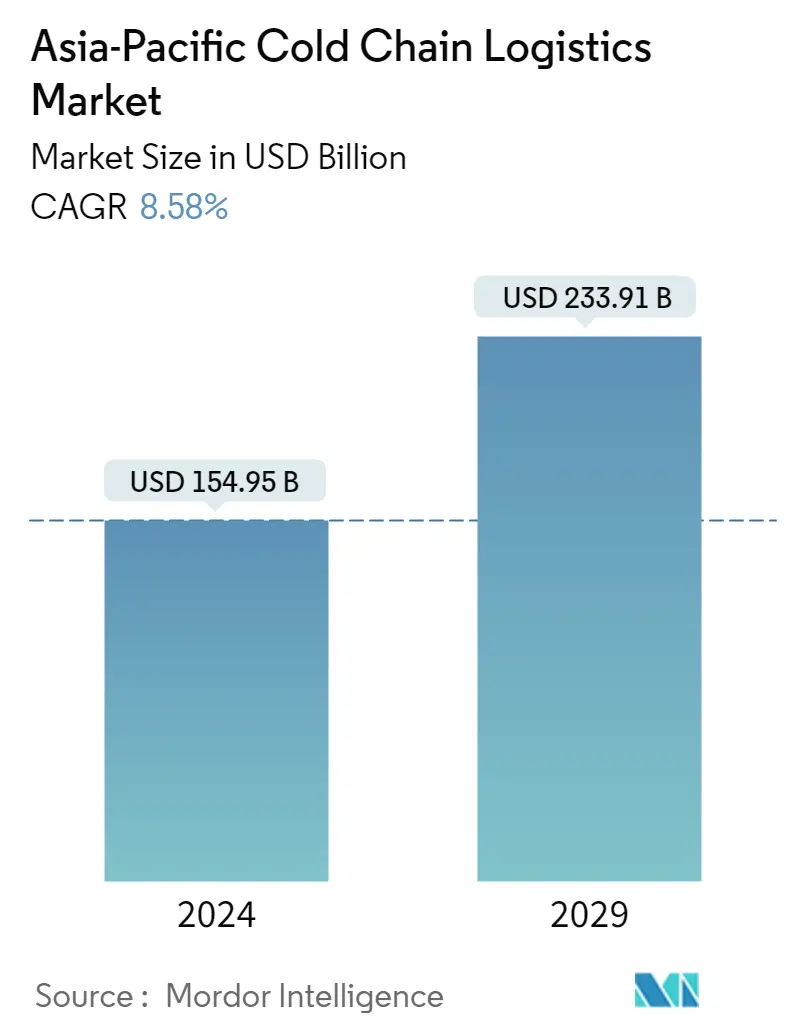Market Size of Asia-Pacific Cold Chain Logistics Industry

| Study Period | 2019 - 2029 |
| Base Year For Estimation | 2023 |
| Market Size (2024) | USD 154.95 Billion |
| Market Size (2029) | USD 233.91 Billion |
| CAGR (2024 - 2029) | 8.58 % |
| Market Concentration | Low |
Major Players
*Disclaimer: Major Players sorted in no particular order |
Need a report that reflects how COVID-19 has impacted this market and its growth?
APAC Cold Chain Logistics Market Analysis
The Asia-Pacific Cold Chain Logistics Market size is estimated at USD 154.95 billion in 2024, and is expected to reach USD 233.91 billion by 2029, growing at a CAGR of 8.58% during the forecast period (2024-2029).
Factors such as the increasing number of refrigerated warehouses and the development of the pharmaceutical sector are expected to drive the growth of the Asia-Pacific cold chain logistics market.
- Cold chain logistics are popular in the Asia Pacific. The region has a large consumer base, accounting for roughly 60% of the global population. Demand for premium products is increasing, driven by rising disposable incomes and a shift in dietary habits. Transportation for these products is also important. Of course, COVID-19 has had an impact on Asian cold chain operations, including increased concerns about food safety. This is already changing consumer habits, with more people buying fresh and frozen food from organized retail channels like supermarkets rather than traditional wet markets. The rise of e-commerce and online food retailing has also fueled demand for frozen foods. These trends have increased the demand for cold storage facilities in the region and bolstered further investments in infrastructure and transportation improvements.
- Japan is regarded as a mature market for cold chain logistics, with several players dominating. Nichirei Logistics Group Inc., based in Tokyo, was founded in 1945 as Nippon Reizo Inc. Today, the company provides warehousing, cold storage, and transportation services in Japan and around the world. Customers in a variety of industries use its low-temperature logistics services, including restaurants, retail stores, food manufacturers, trading companies, and wholesalers. The 'upper limit on overtime hours in automobile driving operations' will be implemented in Japan in 2024, raising concerns about the impact on the transportation and logistics industries. Technological innovation is also expected to improve work efficiency, reduce workplace errors, and prevent accidents.
- The availability of Radio-frequency identification (RFID) technologies for cold chain applications and the adoption of automated software for cold chain logistics is projected to offer lucrative growth opportunities for the market players. Recent years have seen robust demand for high-quality industrial and logistics assets in Asia-Pacific due to strong domestic consumption, the e-commerce industry's expansion, and the development of modern logistics facilities. Due to the rising disposable income and ageing population, Asia-Pacific has a vast consumer base for healthcare supplies. There are increasing concerns over food safety and a continuous shift in consumer habits to buy fresh and frozen food products from organized retail channels, such as supermarkets, compared to traditional wet markets.
- The shift in dietary patterns is increasing the demand for premium products, including meat, dairy, and seafood, which are temperature-sensitive and need to be stored and transported at controlled temperatures. Despite robust leasing demand for cold storage facilities in Asia-Pacific, cold storage capacity in the region is limited compared to that in developed western markets. Cold storage facilities command higher rental premiums than dry warehouses. However, factors such as lack of standardization about operating procedures, security, temperature, pest control, and increased operational costs restrain the market's growth.
